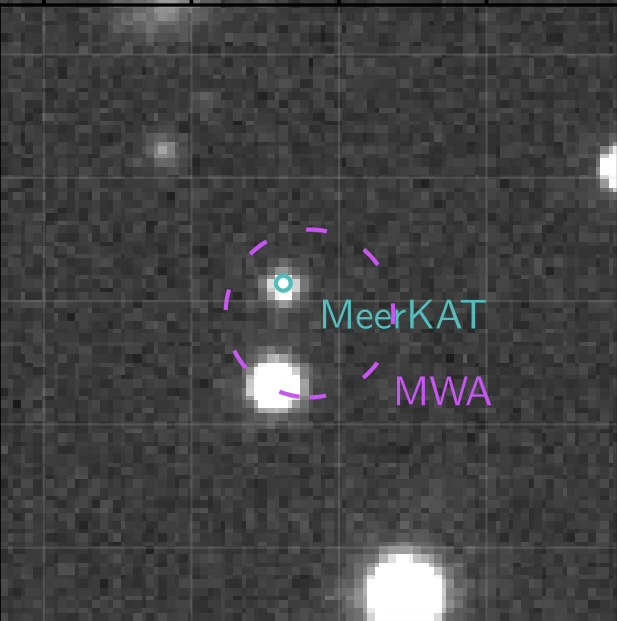
Jan 23, 2025 | News
22/01/2025 - A radio transient with the longest period yet seen, 2.9 hrs, was discovered by a team including Nanda Rea of ICE-CSIC and published in December 2024.
The team found the transient in low-frequency archival data from the SKAO precursor Murchison Widefield Array (MWA). Such long-period radio transients are a fairly new area of research and it is challenging to determine how the signals are generated. In this case, the team managed to find the probable source for the energy bursts, using another SKA precursor, MeerKAT, and optical SOAR observatory, and determine that the optical counterpart is a cool M3 dwarf star. This means that the signal is not due to a magnetar, but more likely is generated in a dwarf binary system scenario.
Read more:
ICE-CSIC press release
ICRAR press release
Paper: Hurley-Walker et al., 2025

Using 2 SKAO precursors, the team could trace the 2.9 hr long-period transient radio source to a specific object and measure its counterpart in optical to find an M3 dwarf star. Image credit: Hurley-Walker at al, 2024..
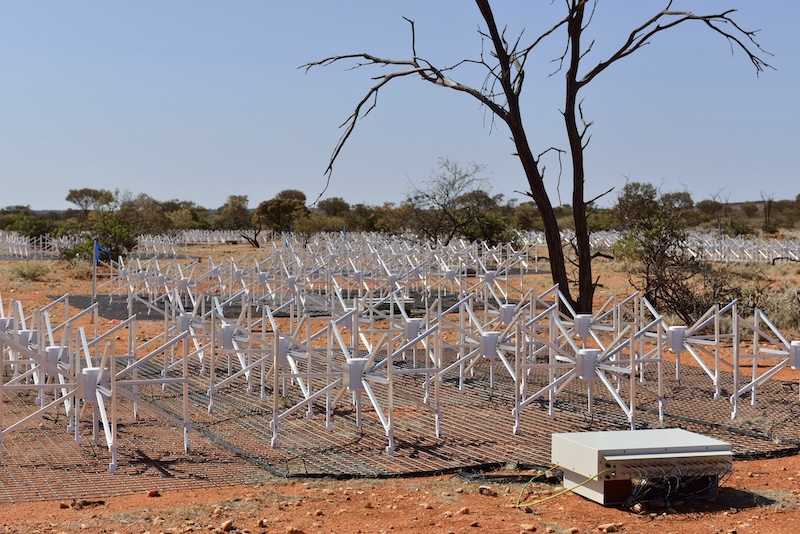
The team found the radio signal in archival data from the Murchison Widefield Array radio telescope, an SKAO precursor. Image credit: ICRAR/Curtin.
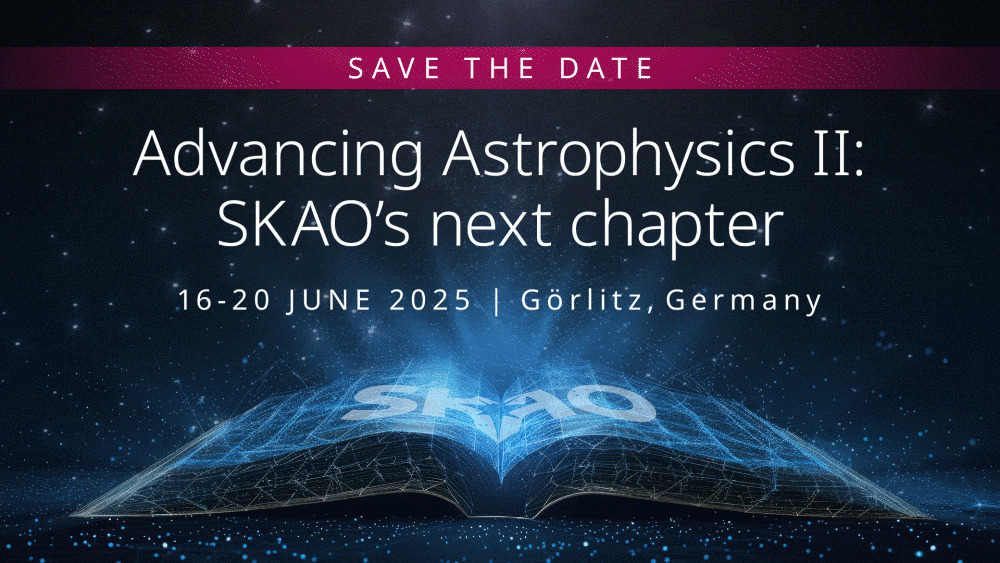
Sep 12, 2024 | News
01/09/2024 – El Observatorio SKA abre a la comunidad científica internacional la convocatoria para contribuir a la nueva edición del libro de ciencia SKA hasta el próximo 30 de septiembre.
El próximo año, durante la Reunión General de Ciencia del Observatorio SKA (SKAO) que se celebrará del 16 al 20 de junio, se cumplirá una década desde la publicación del libro de ciencia de SKA «Advancing Astrophysics with the Square Kilometre Array«. Este libro, escrito por la propia comunidad internacional, documenta los avances científicos que serán posibles gracias a los telescopios del SKA. En estos diez años, el diseño se ha cerrado, la construcción ha comenzado y la Organización SKA se ha transformado en un observatorio en forma de organización intergubernamental que abarca cinco continentes y ambos hemisferios.
Durante este tiempo, las observaciones realizadas con los telescopios precursores y pathfinders de SKA han arrojado nueva luz sobre enigmas científicos ya existentes y han descubierto nuevos fenómenos a la espera de una respuesta. Ahora, el SKAO está listo para comenzar las primeras pruebas para su puesta en marcha, con lo que las actividades de observación irán incrementando rápidamente. Los primeros datos de verificación científica estarán disponibles públicamente para la comunidad en 2027, y las operaciones con ambos telescopios comenzarán en 2029.

Credit: SKA Observatory
En este momento crítico, SKAO invita a la comunidad científica a contribuir a redactar una nueva versión del libro de ciencia del SKAO. El objetivo es proporcionar una cobertura actualizada de las preguntas científicas que abordarán los telescopios del SKA que esté redactada sobre la base de un conjunto maduro de especificaciones y con una variedad de herramientas y documentos disponibles basados en trabajos de diseño detallados y características del entorno de los telescopios del SKA.
El SKAO ha puesto a disposición de la comunidad científica una página donde se encuentran los detalles sobre la presentación de las expresiones de interés en contribuir con un capítulo del libro y sobre la Reunión General de Ciencia del SKAO 2025. Desde el equipo de coordinación de SKA-Spain, animamos a la comunidad española, especialmente al personal que se encuentra en etapas tempranas de sus carreras, a contribuir al libro, ya sea actualizando casos científicos existentes o incluyendo nuevos casos no cubiertos anteriormente. La convocatoria de Expresiones de Interés se cerrará el 30 de septiembre de 2024, serán revisadas por los presidentes de los Science Working Groups de SKA y se invitará a todas las ideas científicas viables a prepararse como capítulos para el libro.
Esta iniciativa presenta una oportunidad única para la comunidad científica española de influir en la dirección de la investigación astronómica internacional de los próximos años. España, como país miembro de SKAO, tendrá acceso tanto a los Key Science Projects (KSPs – proyectos de legado que ocuparan el ~ 70% del tiempo en los primeros 5 años de operaciones) como al tiempo asignado para propuestas de IP, que será proporcional al porcentaje de participación de cada país miembro. Al actualizar y añadir nuevas ideas al libro, la comunidad española podrá contribuir a maximizar el potencial científico de los telescopios del SKA y asegurar que éstos aborden el interés científico nacional, con el objetivo de mantener a la comunidad a la vanguardia de los descubrimientos astronómicos.
En conclusión, la nueva edición del libro de ciencia SKA será una guía esencial para los futuros estudios astronómicos y una plataforma para la colaboración internacional. Desde SKA-Spain, invitamos a todos los interesados a participar en esta emocionante aventura científica y a contribuir con sus conocimientos y experiencias para hacer de esta publicación un recurso valioso y actualizado para la comunidad científica global.
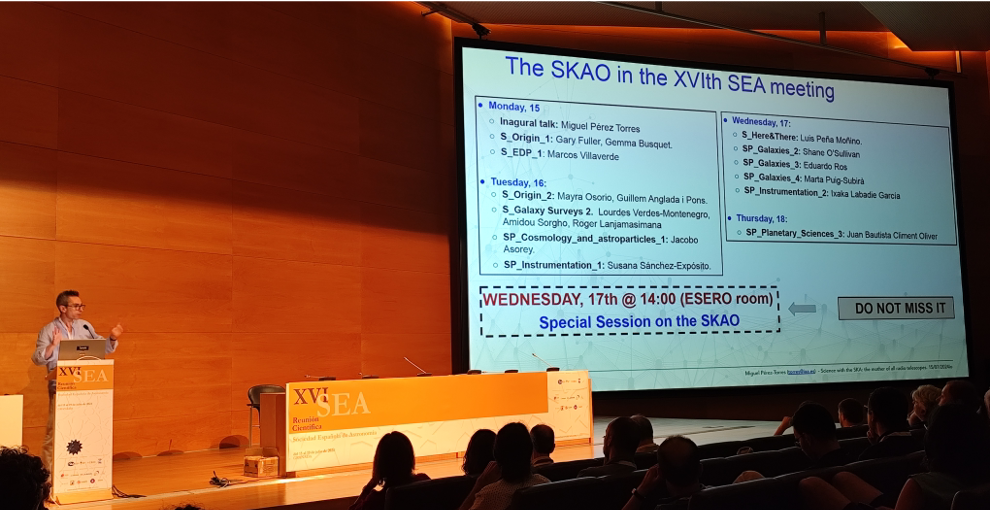
Aug 2, 2024 | News
02/08/2024 – More than 630 participants gathered in Granada to discuss the latest developments in astronomy. The SKA project was extensively discussed, with key presentations on its technological and scientific capabilities, underlining the importance of Spanish collaboration in this global research infrastructure.
From July 15th to 19th, the XVI Scientific Meeting of the Spanish Astronomical Society (SEA, for its acronym in Spanish) was held in Granada, with a record attendance of over 630 participants and more than 400 scientific talks. During this meeting, the latest scientific and technological advances in astronomy and the Spanish participation in major projects and research infrastructures were shared. Among these, the SKA project played a prominent role, as it was the subject of the inaugural plenary lecture, a special session, and also featured in another plenary and talks in various parallel sessions.

Inaugural plenary lecture “Science with SKA: the mother of all radio telescopes” by Miguel Pérez-Torres (IAA-CSIC)
In the inaugural talk, Miguel Pérez-Torres (IAA-CSIC) discussed the capabilities of SKAO telescopes and the scientific research that can be conducted with them, encouraging all attendees to become part of the SKA community by participating in the Science Working Groups. This talk can be watched in full on the SEA's YouTube channel (link). The special session on SKA focused on the latest developments at the SKA Observatory and its international network of Regional Centres (SRCNet), addressing topics such as: the timeline for the construction of SKAO telescopes, updates on scientific cases, the SKA Science Conference to be held in June 2025, the tools already available to the community, the services offered by the Spanish prototype of SKA Regional Centre at IAA-CSIC (espSRC), and the launch of the first functional version of the SRCNet in early 2025.
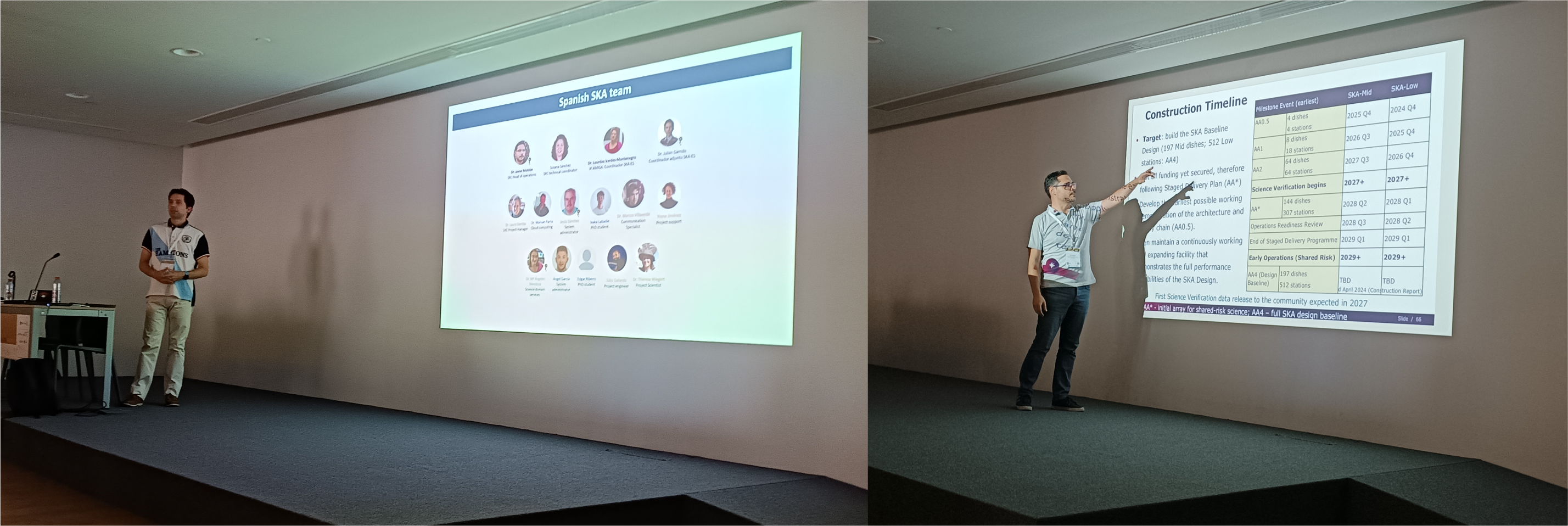
Julián Garrido (IAA-CSIC) and Javier Moldón (IAA-CSIC) during the special session on SKA
The plenary talks on the second day included a presentation by Vanessa Graber (University of Hertfordshire). In this talk, she summarised the work she conducted at the Institute of Space Sciences (ICE-CSIC) on pulsars and long-period radio transients, highlighting observations made with the Murchison Widefield Array, one of the SKAO precursors in Australia. This talk can also be viewed on the SEA's YouTube channel (link).
In the parallel sessions, the SKA project was also discussed from the scientific, technological and science communication aspects. The invited talks by Susana Sánchez (IAA-CSIC) and Lourdes Verdes-Montenegro (IAA-CSIC) were particularly focused on the SKA project. Susana Sánchez discussed Spain's contribution to SRCNet and the TED4SKA project, which aims to reduce the energy consumption of SKA Regional Centres. Lourdes Verdes-Montenegro provided a review of the study of galaxies and their environments using HI observations with SKA precursors and pathfinders.
Three additional talks were also presented on observations with SKA precursors and pathfinders: Jacobo Asorey (UCM) spoke about Cosmology with ASKAP surveys, Roger Ianjamasimanana (IAA-CSIC) presented work on the gas in Hickson compact groups using MeerKAT observations, and Shane O'Sullivan (UCM) discussed observations of the magnetised intergalactic medium conducted with LOTSS surveys from LOFAR and POSSUM from ASKAP.
In the instrumentation and supercomputing session, Ixaka Labadie (IAA-CSIC) presented his research on remote and interactive visualisation of spectral data cubes implemented in the espSRC, which is already being applied to MeerKAT data, a SKA precursor telescope. In a different area, Marcos Villaverde (IAA-CSIC) spoke in the session dedicated to education, outreach, and heritage about the outreach initiatives carried out by SKAO and the role of Open Science in dissemination. It is also worth mentioning a poster by David Alonso-López (UCM) on work conducted within the POSSUM-ASKAP collaboration concerning the magnetised gas in the Shapley supercluster
In addition to all this, SKAO and its telescopes were featured in other talks as a reference for the future. All of this reflects the Spanish community's interest in the SKA project and its science.
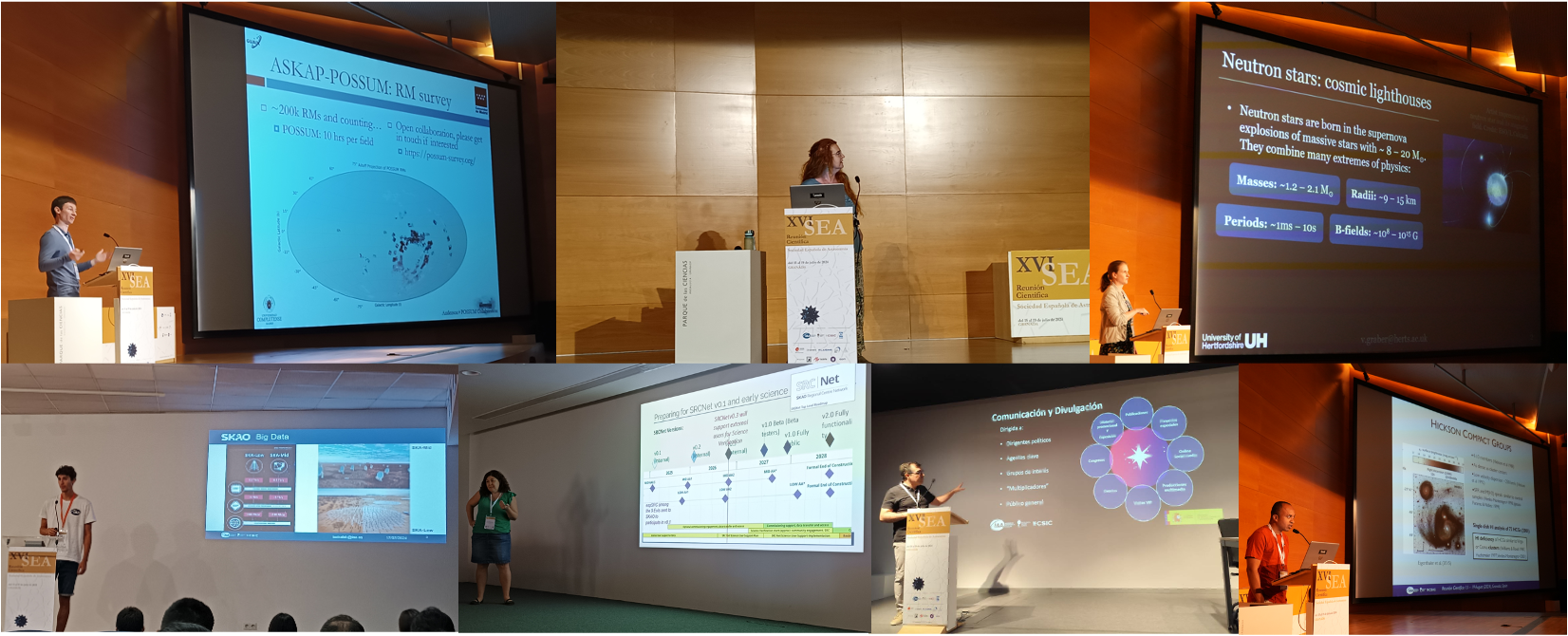
From left to right and from top to bottom: Shane O’Sullivan (UCM), Lourdes Verdes-Montenegro (IAA-CSIC), Vanessa Graber (University of Hertfordshire / ICE-CSIC), Ixaka Labadie (IAA-CSIC), Susana Sánchez (IAA-CSIC), Marcos Villaverde (IAA-CSIC) and Roger Ianjamasimanana (IAA-CSIC)
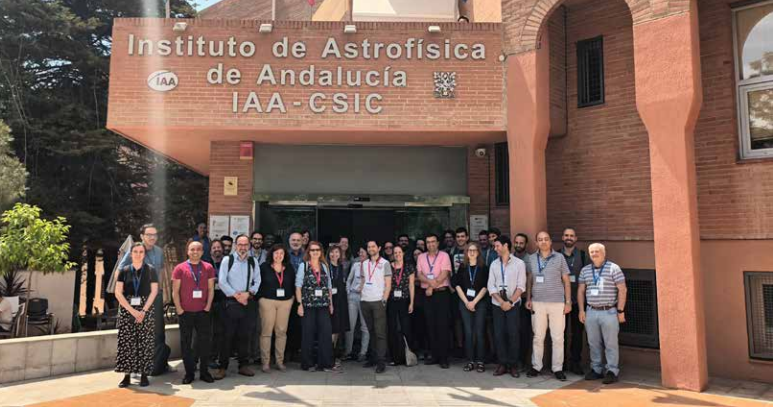
Jun 22, 2023 | News
22/06/2023 – The emerging era of Big Data is demanding a transformation in the way science is done via a growing push to make scientific research more accessible, a movement known as 'Open Science'. To explore what this means in practice for researchers, the first SKA Open Science School took place in Granada, Spain, from 8-10 May 2023, bringing together 80 participants from 14 countries.

The IAA-CSIC Severo Ochoa Open Science school at the Institute of Astrophysics of Andalusia was organised as a fully hybrid meeting,
with around 50% of its participants attending online. Credit: IAA-CSIC
The hybrid school was endorsed by the SKA Regional Centre partner training programme and co-organised with the SKAO under the IAA-CSIC Severo Ochoa Programme.
Participants ranged from graduate students looking for tips on making their thesis work reproducible (making tools and techniques public so that others – and even the original researchers themselves – can achieve the same results later), to the already Open Science-savvy wanting to learn practical tools. Instructors discussed transitions in science practices with accompanying challenges, and presented practical solutions, including hands-on demos. They covered topics on how to make projects/code portable throughout new versions of software, how to best use containers and science platforms, virtual observatories, setting up citizen science projects, licenses, and more.
Discussions continued between sessions on how to change habits that give quick, publishable results (the “publish-or-perish” mentality) and instead invest the time needed for long-term open and reproducible science, including how Open Science work can be appreciated by employers. As Prof. Eva Mendez of Charles III University of Madrid (UC3M) asked: “Are we prepared for a new research evaluation?”
SKAO Scientist Dr Philippa Hartley shared the new SKAO statement on Open Science, including its mission and what Open Science will do for the SKA, and the IAA’s Dr Lourdes Verdes-Montenegro, coordinator of the Spanish participation in the SKA, noted that “large scientific infrastructures have an ethical role and a practical need in Open Science”.
Sessions from the Open Science school are publicly available
on the school webpage.
May 17, 2023 | News
17/05/2023 – These bursts, which show a similar luminosity in almost all cases, are used to measure distances in the universe or to study dark energy. The study, in which the Institute de Astrophysics de Andalusia (IAA-CSIC) participates, shows that the explosion occurred in a double star system in which a white dwarf stole material from its solar-type companion. El trabajo, en el que participa el Instituto de Astrofísica de Andalucía (IAA-CSIC), muestra que la explosión se produjo en un sistema doble de estrellas en el que una enana blanca robaba material de su compañera, de tipo solar.
Type Ia supernovae are produced when a white dwarf, the "corpse" of a Sun-like star, absorbs material from a companion star and reaches a critical mass, equivalent to 1.4 solar masses, triggering an explosion whose luminosity will, given its origin, be similar in almost all cases. This uniformity made Type Ia supernovae the ideal objects for measuring distances in the Universe, but the origin and nature of the progenitor system was unknown. Now, the first radio observation of a type Ia supernova confirms that it comes from a double star system consisting of a white dwarf and a solar-type star. The results are published in the journal Nature.
"When we saw signs of a strong interaction with the companion star material in supernova SN2020eyj, we tried to observe the explosion in radio, something that had been attempted without success for decades", explains Erik Kool, a researcher at Stockholm University and lead author of the paper.
Type Ia supernovae always contain a white dwarf, which receives material from its companion. However, it was not known whether this companion was a white dwarf or a Sun-like star, something that radio imaging could reveal.
“This first radio detection of a type Ia supernova is a milestone that has allowed us to demonstrate that the exploded white dwarf was accompanied by a normal, non-degenerate star before the explosion", says Javier Moldón, a researcher at the IAA-CSIC who participated in the discovery. In addition, with these observations we can estimate the mass and geometry of the material surrounding the supernova, which allows us to better understand what the system was like before the explosion.
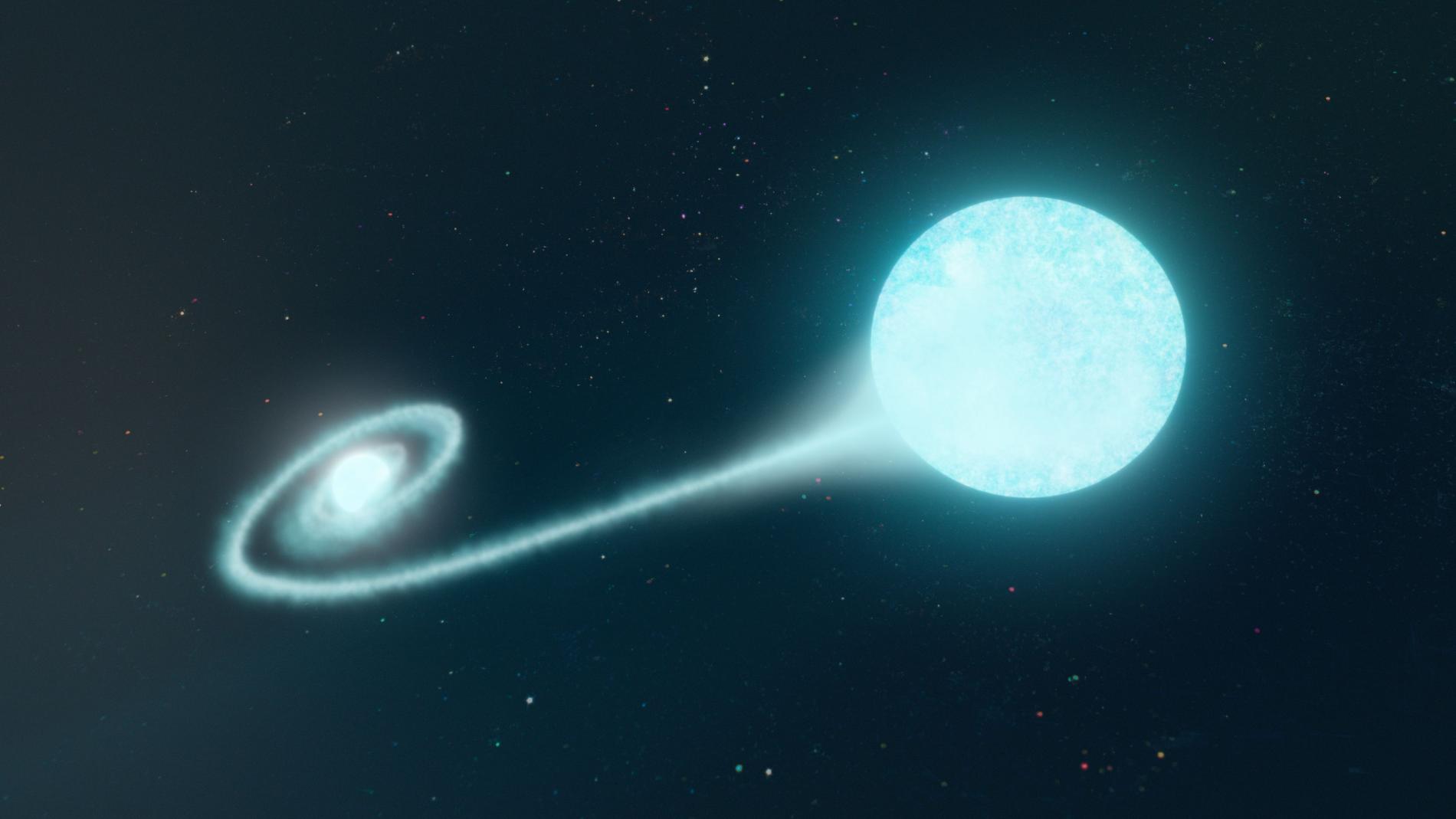
Artist's conception of the system that produced the supernova, in which a white dwarf star absorbs material from its companion star. Source: Adam Makarenko/W. M. Keck Observatory.
This work, whose contribution in radio data was led by the IAA-CSIC, has confirmed that the material expelled in the supernova explosion collided, after travelling sixty days, with the material surrounding the system, composed mostly of helium, which indicates that the companion star was not a white dwarf. Furthermore, models predicted that the radio emission, if present, would take many months to be detectable, and indeed the science team had to wait a year and a half to detect the supernova's radio counterpart.
“The unusual light curve of SN 2020eyj, the infrared emission, the detection of helium emission lines and the unprecedented radio detection make this supernova unique, a treasure of information with implications for multiple fields of research", says Miguel Pérez Torres, an IAA-CSIC researcher participating in the study. “Studying more similar systems will allow us to better understand the origin of these standard candles and the chemical evolution of galaxies”.
"Now that we have shown that radio observations can provide direct and unique information to understand this type of supernovae, it opens a path to study these systems with the new generation of radio instruments, such as the Square Kilometre Array Observatory (SKAO) in the future", concludes Javier Moldón (IAA-CSIC).
The result has been possible thanks to e-MERLIN, an array of very high angular resolution radio telescopes, and the analysis of the data has been carried out from the Spanish prototype of the SKA Regional Centre (SPSRC) of the IAA-CSIC, which is supported by the Severo Ochoa project of the IAA and which facilitates the processing of data from SKAO pathfinders, such as e-MERLIN.
[/et_pb_text][/et_pb_column]
[/et_pb_row]
[/et_pb_section]










